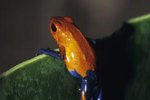
The existence of the purple frog (Nasikabatrachus sahyadrensis), also known as the pig-nosed frog, was not known until 2003. These burrowing frogs are the last of a group of ancient amphibians that evolved over 120 million years ago. They are extremely rare and listed as an endangered species. Field researchers have identified only 135 individuals, and all but three of these were male.
Physical Description
Pig-nosed frogs get their colloquial names from their purple skin and their short, piglike snouts. The purple coloration fades to gray on the frogs' undersides. They have round, bloated boiesy. Their stubby legs end in web feet with rounded toes adapted to suit their underground environment and burrowing lifestyle. Purple frogs grow to around 3 inches long.
Diet and Habitat
Pig-nosed frogs exist naturally only in the Western Ghats of India, a mountain range that runs along the southwestern side of the country. These reclusive animals burrow 4 to 12 feet underground in search of termites, which are their primary food source. Purple frogs require loose, damp soil in which to dig, preferably near termite mounds. They also consume ants and small worms. The frog’s narrow mouth keeps it from consuming anything larger.
Behavior
Purple frogs spend most of their lives underground, coming to the surface for only a few weeks each year to breed during the monsoon season. The frogs were discovered when people local to the area reported seeing the bizarre-looking purple frogs stuck together in pairs, leading scientists to believe the frogs may have mating habits similar to the short-headed frogs of the Brevicipitidae family. The females lay eggs in ponds swollen with rain, typically near moving streams.
Connection to Seychelles Frogs
Scientists have concluded the purple frogs are the closest relatives of the Seychelles frogs, although they don’t look anything alike. The Seychelles islands, which broke away from the east coast of India 65 million years ago, are the only islands in the world with endemic frog species. Pig-nosed frogs are native to the west coast of the country. Scientists speculate the two species have evolved independent of each other for some 130 million years. The four species of Seychelles frogs include the world’s smallest specimens, with the adults of some species reaching less than half an inch in length.
References
Resources
Photo Credits
-
Hemera Technologies/PhotoObjects.net/Getty Images
Writer Bio
Jennifer Mueller began writing and editing professionally in 1995, when she became sports editor of her university's newspaper while also writing a bi-monthly general interest column for an independent tourist publication. Mueller holds a Bachelor of Arts in political science from the University of North Carolina at Asheville and a Juris Doctor from Indiana University Maurer School of Law.



